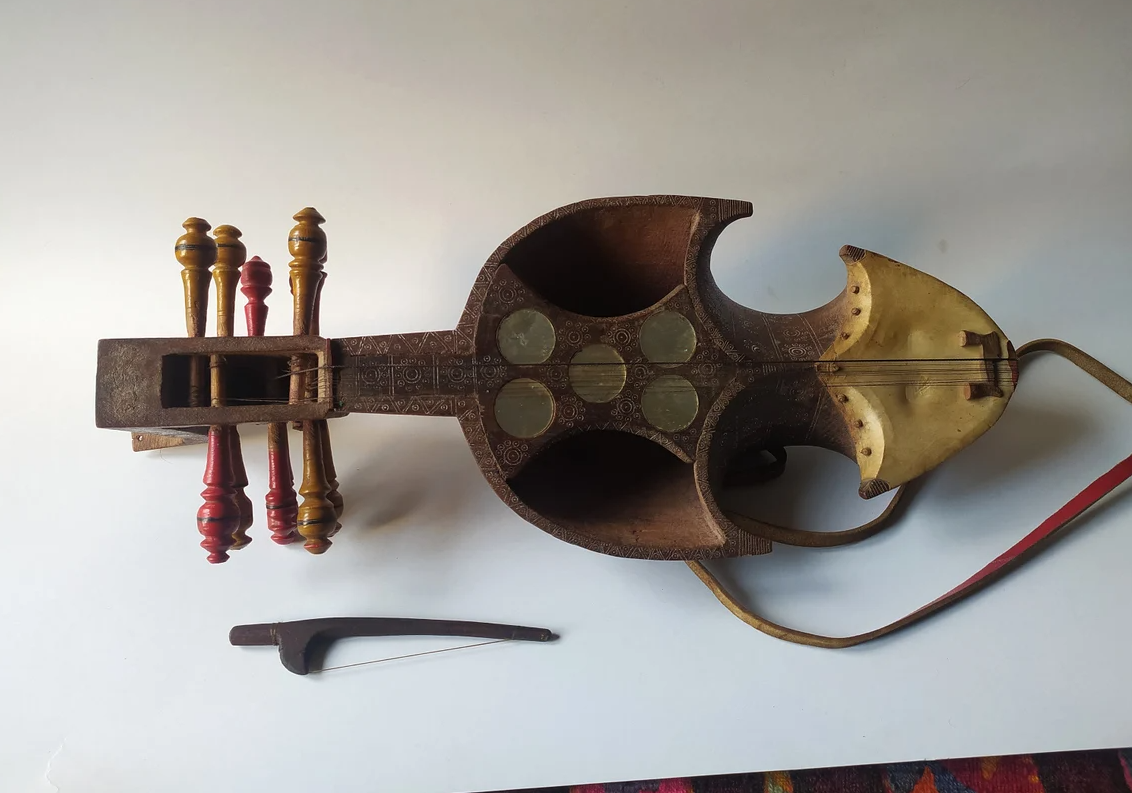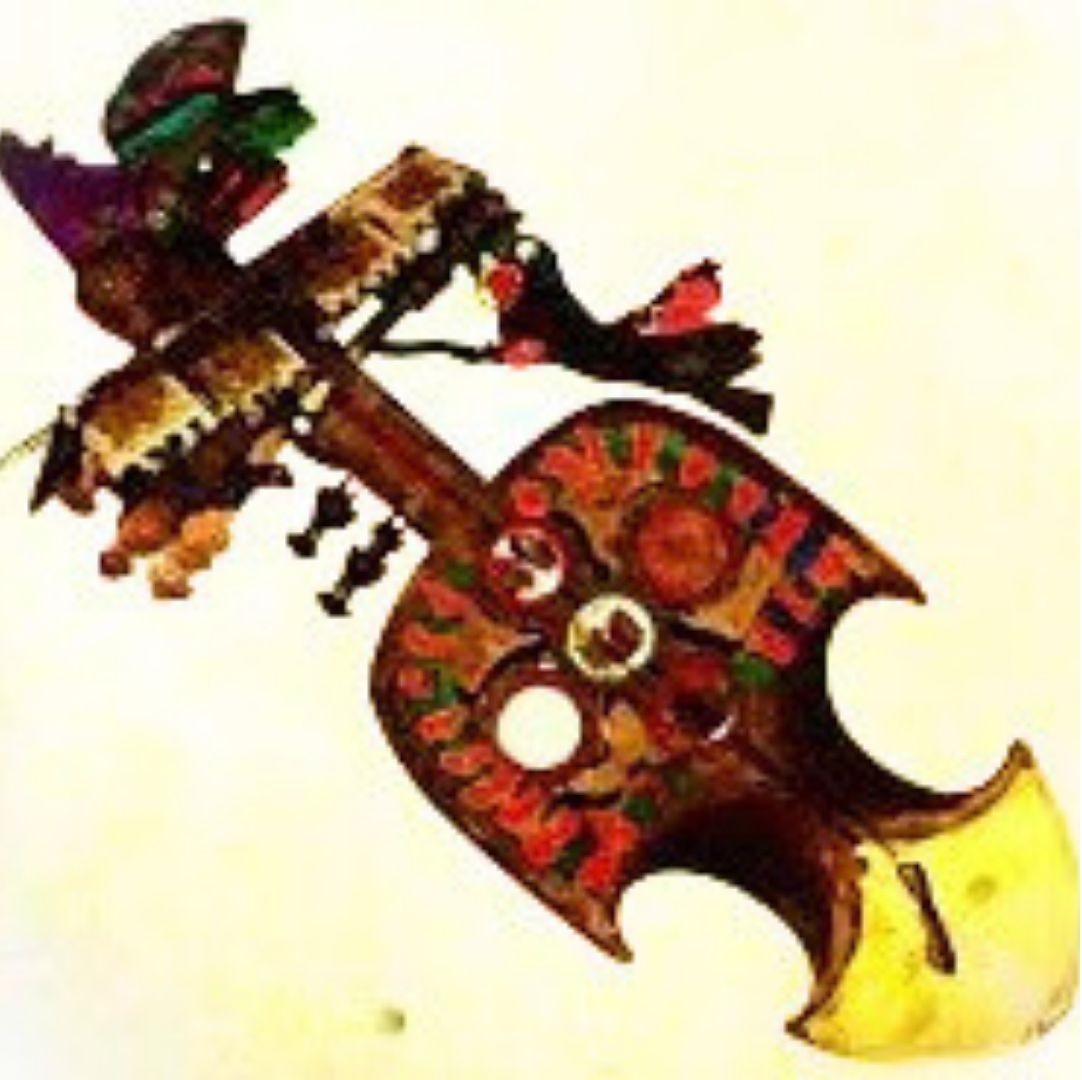Suroz
Bowed Instruments
Asia
Between 1001 and 1900 AD
Video
The Suroz is a traditional bowed string instrument that holds a significant place in the musical heritage of the Baloch people, primarily found in Pakistan and Iran. It resembles a fiddle or sarangi, featuring a long neck, and is typically played vertically.
The instrument is characterized by its three main strings, which are made from gut or synthetic materials, and often include sympathetic strings that enhance its tonal richness. The Suroz produces a soulful sound that resonates deeply with the emotional themes prevalent in Balochi music. Musicians play the Suroz using a bow, drawing it across the strings to create melodies that are both haunting and melodious. The instrument’s design allows for intricate finger placements and bowing techniques, enabling players to express a wide range of emotions through their performance. The Suroz is not only an instrument but also a storyteller, conveying the rich narratives of Balochi folklore and culture.
History of the Suroz
The history of the Suroz can be traced back to the 16th century in the region that is now known as Balochistan, which spans parts of modern-day Pakistan and Iran. The instrument is believed to have evolved from earlier Persian string instruments, reflecting the cultural exchanges that have taken place across this region over centuries. As a member of the bow and string family, it shares similarities with various other instruments found throughout Central Asia and the Indian subcontinent. During its early days, the Suroz was primarily used in folk music settings, accompanying storytelling and dance during community gatherings. Its significance grew as it became associated with various cultural events, including weddings and festivals. Throughout the years, renowned musicians such as Ustad Mumtaz Sabzal have contributed to its popularity by incorporating innovative playing techniques and styles into their performances. Despite facing challenges due to modernization and changing musical tastes, efforts have been made to revive interest in traditional instruments like the Suroz. Cultural organizations and musicians are actively working to preserve its legacy by teaching younger generations about this unique instrument.
Materials Used in Construction
The construction of the Suroz involves natural materials that are locally sourced. The body of the instrument is typically made from wood, often carved from trees such as the Parpuk tree found in Balochistan. This wood is chosen for its durability and acoustic properties, which contribute to the instrument’s rich sound. The strings are traditionally made from animal gut, although modern versions may use synthetic materials for enhanced durability and consistency in tone. The craftsmanship involved in creating a Suroz requires skilled artisans who understand both the functional and aesthetic aspects of instrument making.
How It Works
The Suroz produces sound through the vibration of its strings when played with a bow. Musicians draw the bow across the strings while pressing down on them with their fingers to create different pitches. This interaction between bowing technique and finger placement allows for expressive playing that can convey a wide range of emotions. The sympathetic strings, which run beneath the main strings, vibrate in response to the played notes, adding depth and resonance to the overall sound. This feature enhances the instrument’s ability to produce complex harmonies and textures, making it suitable for both solo performances and ensemble settings.
Types of Suroz
While there is primarily one standard type of Suroz associated with Balochi culture, variations may exist based on regional preferences or individual craftsmanship. Some musicians may customize their instruments by adjusting string materials or incorporating additional sympathetic strings to achieve specific tonal qualities.In addition to these variations, related instruments such as other types of bowed string instruments can be found within Balochi music traditions. Each instrument offers unique characteristics while sharing similarities in construction and playing technique.
Features of the Suroz
Key features of the Suroz include:
Three Main Strings: Allows for melodic playability.
Sympathetic Strings: Enhances tonal richness and resonance.
Long Neck: Facilitates intricate finger placements.
Wooden Body: Provides durability and contributes to sound quality.
Bowed Technique: Requires skillful bowing for dynamic sound production.
These features collectively contribute to the distinctiveness of the Suroz within Balochi music traditions.
Music Composed for the Suroz
Music composed for the Suroz often reflects traditional themes deeply rooted in Balochi culture. It serves as an accompaniment to folk songs that narrate stories about love, nature, and daily life experiences. The melodies played on this instrument typically incorporate improvisation and ornamentation, showcasing both tradition and individual creativity.In ensemble settings, the Suroz interacts with other traditional instruments such as drums or flutes, creating rich textures that enhance communal experiences during performances. Its ability to convey emotion makes it particularly suited for expressing themes related to joy, sorrow, and cultural identity.
Cultural Significance
The cultural significance of the Suroz extends beyond its musical role; it embodies aspects of identity and heritage among Baloch people. As an instrument traditionally associated with storytelling and community gatherings, it represents a connection to cultural roots and shared experiences. Efforts to preserve traditional music practices have sparked renewed interest in learning how to play instruments like the Suroz among younger generations. This revival not only helps maintain cultural traditions but also fosters community cohesion through shared musical experiences.
The Suroz is more than just an instrument; it is a vital part of Balochistan’s cultural landscape that continues to resonate with audiences today.
FAQ
What is the origin of the Suroz musical instrument?
The Suroz is believed to have originated in Central Asia, specifically in the regions of Iran and Afghanistan. It has a long history, dating back to ancient Persian music traditions. The instrument spread to neighboring regions, evolving over time. It is used in both classical and folk music, representing cultural diversity across the region.
What is the Suroz made of?
The Suroz is traditionally made from wood, typically using high-quality hardwoods like walnut or rosewood. The body is carved and hollowed to create a resonating chamber. The strings are made of steel or gut, and the bow is usually crafted with horsehair. These materials combine to produce a rich, resonant sound.
What kind of music is the Suroz used in?
The Suroz is primarily used in classical and folk music, especially in the traditional music of Central Asia and Iran. It plays a key role in orchestral and solo performances. The instrument is known for its expressive range and is often used in storytelling through music. It adds emotional depth to various regional music genres.
 Links
Links
References
Other Instrument
Categories



















